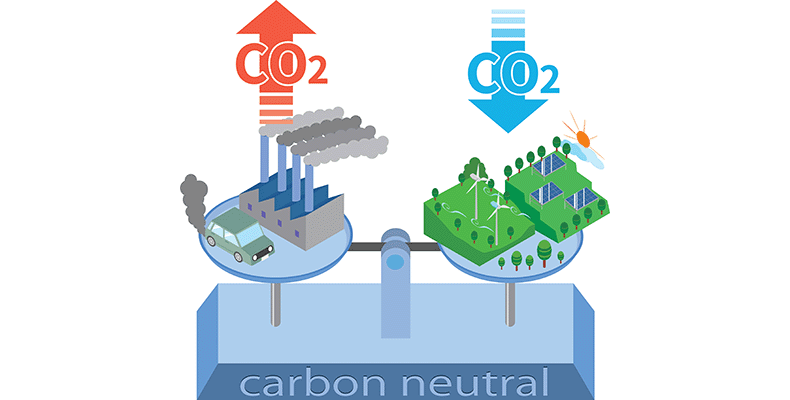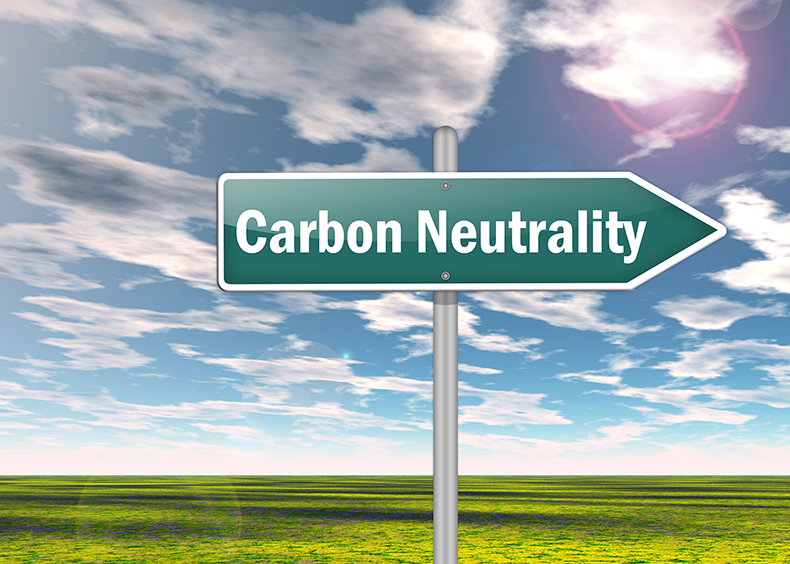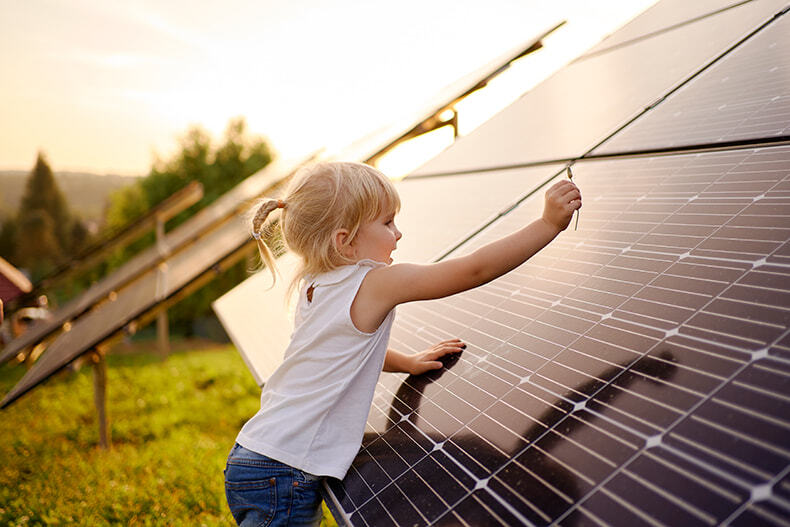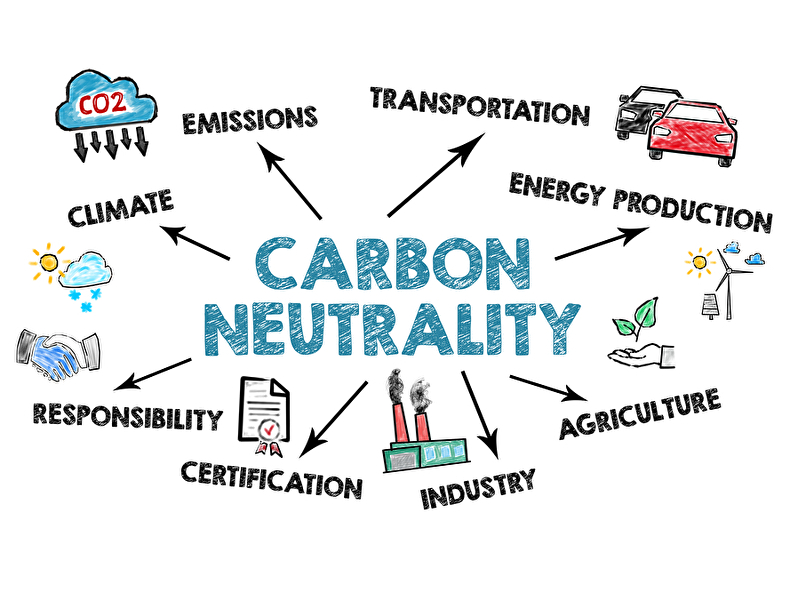Around the world, there is a growing movement towards carbon neutrality. Buzzwords such as "decarbonization" and "carbon neutral" can be commonly encountered in the media, and companies and local governments are putting forward their best efforts. This article will introduce a basic overview of carbon neutrality, look at examples of good practice from around the world, and introduce Fujitsu's own initiatives for the occasion of World Environment Day on June 5. But firstly, what exactly is carbon neutrality anyway? And what initiatives are trending around the world in this area? With these ideas in mind, let's go and explore the present and future of carbon neutrality.
- Table of Contents
What Is Carbon Neutrality? And Why Should We Pursue This?

Carbon neutrality is the idea of reducing the amount of greenhouse gas emissions generated by human operations to net zero by subtracting the amount of absorption performed by forests and other sources.
Among all of the greenhouse gases emitted into the atmosphere, carbon dioxide emissions form the highest percentage. It is said that 65% of these carbon dioxide emissions come from fossil fuels. In particular, the carbon dioxide emitted by companies in developed countries through their business activities has become a major issue. In addition, methane gas, which is contained in the burps of livestock, also accounts for a relatively large proportion, about 15% of the total.
Needless to say, if we leave things as they are, the temperature of the earth will continue to rise. The average global temperature has already risen by 0.73 degrees over the last 100 years, and the average temperature in Japan has risen by about 1.3 degrees. At present, we are seeing a range of effects from this rise, such as heavy rain and extreme heat. However, in the future, for example, some countries will disappear due to rising sea levels, more lives will be lost due to heavy rain and extreme heat, and our life-giving soils may disappear. More serious climate change and ecological impacts are predicted, and it has been pointed out that we are truly in a state of waiting.
In order to manage this situation, the Paris Agreement of 2015 committed to "holding the increase in the global average temperature to well below 2℃ above pre-industrial levels and pursuing efforts to limit the temperature increase to 1.5℃ above pre-industrial levels" and to "achieve a balance between anthropogenic emissions by sources and removals by sinks of greenhouse gases in the second half of this century." This is the method chosen by the world, and it has led to rapid progress being made around the world.
Carbon Neutrality Is So Last Year! The New Trend Is What's Beyond That

Recently, terms such as "carbon positive" and "resource positive" have been attracting a lot of attention. The idea is to take a step further from the point of reducing the amount of greenhouse gases to net zero to increasing the amount of greenhouse gases absorbed and reducing the amount of greenhouse gases to negative. Leading carbon neutral companies as well as global companies in Europe and elsewhere have begun to advocate this concept, and it has become a topic of conversation as a way of thinking that goes beyond carbon neutrality.
So far, a major UK-based consumer goods company, a major US outdoor goods manufacturer, and a major Swedish furniture manufacturer have issued statements on carbon positivity, with one company stating that it will invest approximately 180 million US dollars towards carbon positivity.
The global trend is beyond carbon neutral. Although carbon neutrality is starting to progress gradually in Japan, there is significant progress being made in thinking and efforts globally in this respect. In recent years, ESG (environmental, social and governance) investment in Japan has become more active due to the government's efforts. In addition, Japanese companies need to develop their management plans and policies with a focus on not just carbon neutrality, but also on the next step of carbon positivity.
Not Only Large Companies but Medium-sized Ones Too. Global Initiatives to Look Out For

So, what specific initiatives are companies in the world taking? Next, we will introduce some of the unique initiatives from companies around the world.
In March 2021, a leading coffee chain in the United States formally decided on an environmental goal that will halve its carbon dioxide, water, and waste footprint in order to achieve resource positivity. Specifically, the company is committed to making carbon-neutral coffee (raw beans) and has set a goal of halving the water used in this process by 2030. It is worth noting that the company started a team on environmental issues in 2001. For more than 20 years, the company has been tackling environmental problems with a sense of urgency, conducting surveys and research, and gradually incorporating goals and measures into its management strategies. It is important to understand that the company's declaration regarding resource positivity comes as the result of many measures, including the use of renewable energy for the electricity used in its stores and the elimination of plastic straws.
A major tire manufacturer in France is also undertaking impressive initiatives. The company is working on a project to develop "decarbonized tires" by increasing the amount of natural material in race tires. In June 2021, the company announced that it had developed a tire made from 46% environmentally sustainable materials, and stated its goal of using 100% sustainable materials by 2050. At the same time, the company is also committed to decarbonizing its business activities, and is poised to achieve carbon neutrality by 2050. In this way, the company is aiming to achieve comprehensive decarbonization in both its products and its business activities.
In Europe, not only large companies, but also medium-sized companies are actively engaged in reducing their carbon footprints. A British herbal tea manufacturer is working to switch 100% of its office electricity consumption to renewable energy, while educating consumers to boil only the amount of water they need in their kettle and to use energy-efficient eco-friendly kettles. They are also actively encouraging their clients to do the same. As a further example, an Italian winemaker has also succeeded in significantly reducing its carbon footprint by using solar power to control the temperature in its wine warehouses and by using recycled glass for its bottles.
While companies vary in size and scope, many are starting small and doing what they can to help achieve their long-term goals. It is important not to postpone efforts toward carbon neutrality, but rather to start right away. Instead of thinking about when we will be ready to start, we should be mindful that the process will take a long time and aim to take action as soon as possible.
The Situation in Japan and Fujitsu's Efforts: Implementation Phase Is Go!

Finally, let's take a look at the current situation in Japan and the case of Fujitsu. In Japan, a range of government-led or supported activities for carbon neutrality are underway. These include initiatives to certify and support municipalities that aim to become carbon neutral as "zero carbon cities" as well as "energy mix" initiatives that combine thermal, nuclear, and renewable energy sources in order to generate electricity. In addition, major companies are also making efforts toward carbon neutrality. These include a housing manufacturer, which is working on the development and sale of eco-friendly housing; an automobile manufacturer, which has significantly increased its sales ratio of EV vehicles; a logistics company, which is switching 100% of its factory power consumption to renewable energy; and more. From these examples, we can see that many companies are doing good things in regard to carbon neutrality.
Fujitsu has also implemented a number of initiatives aimed at carbon neutrality. In April 2021, we began an initiative to convert all power used at the Kawasaki Main Office, the largest facility within the Fujitsu Group, to renewable energy (*1). While in September of the same year, the Shiodome Head Office also switched all of its electricity to renewable energy sources. At present, the Fujitsu Group is also in the process of converting data centers and other facilities to renewable energy sources. Furthermore, Fujitsu is engaged in a joint project with IHI Corporation to create a platform for trading environmental values such as carbon dioxide reductions using blockchain technology (*2). And in another example, from November 2021 to March 2022, Fujitsu assisted SB Technology in conducting verification experiments to visualize carbon dioxide emissions and reductions from official vehicles (EVs) in four municipalities using CADDE (Connector Architecture for decentralized Data Exchange), which enables data exchange across different fields (*3). As can be seen from these examples, we at Fujitsu are actively engaged in activities, development, and experiments to realize carbon neutrality both within our company and within wider society.
Fujitsu's activities regarding carbon neutrality are not limited to Japan. Since April 2022, Fujitsu has been working with the Icelandic venture company Atmonia to conduct research on the clean synthesis of ammonia, which is attracting attention as a next-generation carbon-free energy source that emits no carbon dioxide when burned (*4). In addition, we have signed a partnership agreement with Botanical Water Technologies, a British company that has developed a revolutionary patented technology to filter water that has been discarded in the process of concentrating fruits, vegetables, sugarcane, etc., and convert this into "pure water of plant origin" (Botanical Water). Fujitsu is working with Botanical Water Technologies to provide the digital infrastructure and support to develop this technology model on a global scale (*5).
In recognition of these and other contributions, Fujitsu has been selected as a climate change A List company for five consecutive years in the climate change and water security surveys conducted by CDP. In addition, Fujitsu has been selected as a water security A List company for three consecutive years (*6). Fujitsu and Ridgelinez also provide the consulting services which contributes to realize the clients' SX (Sustainability Transformation) and the unique solution services (*7) to calculate and visualize CO2 emissions to assist their clients in achieving SDG-related initiatives. Fujitsu has collected and refined this unique information and experience and is developing services for the manufacturing industry. Through these initiatives and more, we are committed to promoting carbon neutrality more widely and deeply in society.
In January 2022, the Japanese Ministry of Economy, Trade and Industry (METI) announced the GX (Green Transformation) League Basic Concept. The GX League is a place where companies actively engaged in GX can discuss and practice social reform together with government, academia, and finance. With the movement to create the GX League underway, it is expected that initiatives toward carbon neutrality will soon be picked up not only by large companies but also medium-sized companies and the general public in Japan as well. Interest in and efforts towards carbon neutrality continue to accelerate. In order to keep up with this trend, Fujitsu encourages all companies, regardless of whether you are a large or medium-sized company, to take action today and get started.
Related Information
- *1 What Business Can Do for Society Through the Introduction of Renewable Energy
- *2 [Press Release] Fujitsu and IHI start joint project on new environmental value distribution platform using blockchain technology
- *3 [Press Release] An experiment to promote zero carbon city measures in local governments: Visualizing carbon dioxide reductions by utilizing a range of data including public-use EV driving information
※Japanese version only - *4 [Press Release] Fujitsu and Atmonia leverage HPC and AI technology in joint project to contribute to carbon neutrality
- *5 Sustainable manufacturing: Turning wine into water
- *6 [Press Release] Fujitsu Earns Top Rating from CDP in Climate Change, Water Security Categories
- *7 Sustainable transformation must be a priority for every company―Here’s why and how to achieve it




